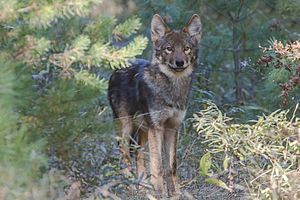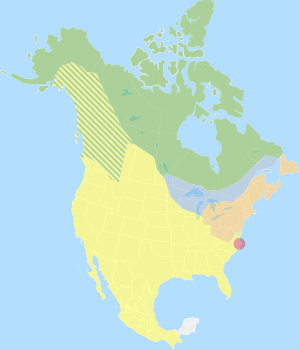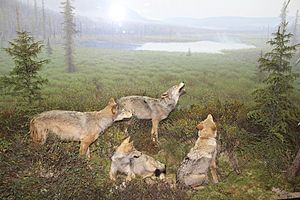Eastern wolf facts for kids
Quick facts for kids Eastern wolf |
|
|---|---|
 |
|
| A wolf in Algonquin Provincial Park | |
| Scientific classification |
|
| Kingdom: | Animalia |
| Phylum: | Chordata |
| Class: | Mammalia |
| Order: | Carnivora |
| Family: | Canidae |
| Genus: | Canis |
| Species: |
C. lycaon
|
| Subspecies: |
C. l.
|
| Trinomial name | |
| Canis lycaon Schreber, 1775
|
|
 |
|
| Blue: Where the Eastern wolf lives | |
| Synonyms | |
|
|
The eastern wolf (also known as the timber wolf or Algonquin wolf) is a type of wild dog found in the Great Lakes region and southeastern Canada. Scientists are still debating if it's a unique kind of grey wolf, a red wolf, or its own separate species. Many studies suggest the eastern wolf is a mix of wolf and coyote genes. Other studies think it might be the same species as the red wolf, or a very close relative.
No matter its exact scientific name, the eastern wolf is special and needs protection. Canada, for example, protects the eastern wolf population in eastern Canada, calling it the "Algonquin wolf."
There are two main types of eastern wolf. The larger one is called the Great Lakes wolf. It lives in places like Minnesota, Wisconsin, Michigan, Manitoba, and northern Ontario. The smaller one is the Algonquin wolf, found in central and eastern Ontario and southwestern Quebec. Sometimes, these two types live in the same areas and mix.
The eastern wolf looks like it's in between a gray wolf and a coyote in size. Its fur is usually a mix of grayish-brown and cinnamon colors. Its neck, shoulders, and tail are black and gray, while its sides and chest are reddish or creamy. Eastern wolves mostly hunt white-tailed deer. They might also hunt moose and beavers sometimes.
In the United States, there's a discussion about removing protections for gray wolf populations in the Great Lakes region. In Canada, the eastern wolf is listed as a species that needs protection. In 2015, experts in Canada recognized the eastern wolf (Algonquin wolf) as a threatened species. The biggest danger to these wolves is hunting and trapping by humans outside of protected areas. This can lead to them mating with eastern coyotes if there aren't enough other wolves around. Human development near protected areas and negative views of wolves also stop them from spreading to new places.
Contents
What is an Eastern Wolf?
The eastern wolf was first described in 1775 by a German scientist named Johann Christian Daniel von Schreber. He based his description on a wolf thought to be caught near Quebec. Later, it was classified as a subspecies of the gray wolf.
However, scientists have been debating this classification for a long time. In 2005, a mammalogist (a scientist who studies mammals) named W. Christopher Wozencraft listed the eastern wolf as a gray wolf subspecies. But since then, new studies, especially those looking at DNA, have led to different ideas. Some think it's a gray wolf that has mixed with coyotes, or a hybrid of a gray wolf and a red wolf. Others believe it's the same species as the red wolf, or even its own unique species.
In 2021, the American Society of Mammalogists decided to recognize the eastern wolf as its own species, called Canis lycaon.
Why Scientists Debate
When European settlers first came to North America, coyotes mostly lived in the western parts of the continent. They preferred dry areas and open plains. But since the mid-1800s, coyotes have been spreading to new places.
The debate about North American wolves often comes down to two main ideas:
- Two-species idea: This idea says that gray wolves and western coyotes are two separate species. Other animals like the Great Lakes wolf, eastern coyote, red wolf, and eastern wolf are all mixes (hybrids) of these two.
- Three-species idea: This idea says that gray wolves, western coyotes, and eastern wolves are all separate species. In this view, Great Lakes wolves are a mix of gray wolves and eastern wolves. Eastern coyotes are a mix of eastern wolves and western coyotes. And red wolves are considered to be the same species as the eastern wolf, or very closely related.
One scientist, Robert K. Wayne, explained the difference by saying, "In a way, it is all semantics. They call it a species, we call it an ecotype." This means it's partly about how scientists define a "species" or a "type" of animal.
Clues from the Past
Some of the oldest wolf bones found in North America are from Alaska and are about 810,000 years old. The teeth measurements of these ancient wolves are very similar to those of eastern wolves from Minnesota. This suggests that eastern wolves have a long history in North America.
DNA Clues
Scientists use DNA to learn about how animals are related. Mitochondrial DNA (mDNA) is passed down from mothers and can show relationships going back thousands of years.
In 1991, a study found that wolves in Minnesota, Ontario, and Quebec had coyote DNA. This suggested that male gray wolves were mating with female coyotes in areas where forests had been cut down.
Another study in 2000 looked at red wolves and eastern wolves. It found that these two wolves often mixed with coyotes. The study showed that red wolves and eastern wolves were closely related to each other and to coyotes, but less so to gray wolves. It suggested that red wolves and eastern wolves might have developed in North America from a common ancestor with coyotes, rather than being a subspecies of the gray wolf.
More recent studies using advanced DNA techniques have continued to explore these relationships. Some studies suggest that North American wolves and wolf-like animals are a mix of gray wolf and coyote genes. For example, the Great Lakes wolf might have about 25% coyote ancestry, and the Algonquin wolf about 40% coyote ancestry.
However, other scientists disagree. They argue that the eastern wolf is not just a hybrid but a separate species. They point to unique DNA markers in eastern wolves that are not found in gray wolves or coyotes. This debate shows how complex it is to understand the history and relationships of these animals.
In 2018, a study looked at the Y-chromosome (passed down from fathers) in canines. It found that one Great Lakes wolf had very different DNA from others, suggesting more research is needed to understand its unique male lineage.
Newer DNA Evidence
In 2016, a study that looked at the entire DNA of wolves and coyotes suggested that all North American wolves and coyotes came from a common ancestor less than 117,000 years ago. This study also found that all North American wolves have a lot of coyote DNA, and all coyotes have some wolf DNA. Red wolves and eastern wolves are a mix of gray wolf and coyote DNA, but in different amounts.
The study suggested that as European settlers arrived and hunted wolves, wolf populations declined. This led to more mixing between wolves and coyotes. The Great Lakes and Algonquin wolves show a distinct type of gray wolf that has also mixed with coyotes.
Because of these findings, the American Society of Mammalogists now recognizes Canis lycaon (the eastern wolf) as its own species. However, other scientists still debate these findings, arguing that the methods used might not fully show ancient relationships.
In 2021, a study looking at mDNA suggested that an ancient wolf from the Ice Age, called the Beringian wolf, was an ancestor of some southern gray wolves. It also suggested that a large, wolf-like coyote from the Ice Age was an ancestor of the eastern wolf. This means the eastern wolf might have formed from a mix of these ancient animals long before modern coyotes and wolves arrived.
About the Eastern Wolf
What They Look Like
Charles Darwin heard about two types of wolves in the Catskill Mountains: one was thin and fast like a greyhound, and the other was bigger with shorter legs. The eastern wolf's fur is usually a mix of grayish-brown and cinnamon. Its sides and chest are reddish or creamy, while its neck, shoulders, and tail are black and gray. Unlike gray wolves, eastern wolves rarely have all-black fur.
Eastern wolves are medium-sized, between a coyote and a gray wolf. Females weigh about 53 pounds (23.9 kg) on average, and males weigh about 67 pounds (30.3 kg). They usually live for 3-4 years, but can live up to 15 years. Their size might be because they are adapted to hunting medium-sized prey, similar to the Mexican wolf in the southwestern US.
How They Live
Eastern wolves mostly hunt small to medium-sized animals like white-tailed deer and beavers. This is different from gray wolves, which can hunt very large animals like moose and bison. Even though they are carnivores, eastern wolf packs in Voyageurs National Park eat a lot of blueberries in July and August when they are ripe.
Wolf packs usually avoid each other. Only lone wolves sometimes enter another pack's territory. An average territory for a pack is between 42-71 square miles (110-185 km²). Young eastern wolves can leave their families as early as 15 weeks old, which is much earlier than gray wolves.
Where They Live
In the past, eastern wolves lived across southern Quebec, most of Ontario, the Great Lakes states, New York State, and New England. Today, the Great Lakes wolf is mostly found in northern Minnesota and Wisconsin, the Upper Peninsula of Michigan, southeastern Manitoba, and northern Ontario. The Algonquin wolf lives in central and eastern Ontario, and southwestern Quebec north of the St. Lawrence River.
Algonquin wolves are especially common in Algonquin Provincial Park and other protected areas nearby. Recent surveys show small numbers of Algonquin wolves in southern parts of northeastern and northwestern Ontario, even as far west as the Lake of the Woods, where they sometimes mix with Great Lakes wolves. They also live in southcentral Ontario, where they sometimes mix with eastern coyotes. There have been some reports of eastern wolves in Quebec south of the St. Lawrence River, New Brunswick, New York State, northern Vermont, and Maine.
History and Protecting Them

Before Europeans arrived in North America, there might have been between 64,500 and 90,200 eastern wolves. In 1942, it was thought that they lived across the wooded and open areas of eastern North America, from southern Quebec to the Great Plains. Native American people in the region did not fear eastern wolves, though they did sometimes catch them in traps.
Early European settlers often kept their farm animals on islands to protect them from wolves. But animals on the mainland were often attacked. So, people in the Plymouth Colony and Massachusetts Bay Colony started campaigns against eastern wolves, offering rewards (bounties) for killing them. Despite this, wolves were still common in New England in the early 1700s. People even discussed building a large fence to keep them out of grazing lands, but it didn't happen. Settlers also used wolf pits, a trapping method they learned from Native Americans. Eastern wolf numbers started to drop before and after the American Revolution. By the early 1800s, few eastern wolves were left in southern New Hampshire and Vermont.
Before Algonquin Provincial Park was created in 1893, eastern wolves were common in central Ontario. They continued to live there even with logging and efforts by park rangers to get rid of them, mainly because there was plenty of deer and beaver to eat. By the mid-1900s, there were many eastern wolf packs in the park. But between 1909 and 1958, about 49 wolves were killed each year. In 1959, the Ontario government officially protected them. By then, the population in and around the park had dropped to 500-1,000 wolves.
Even after protection, researchers culled (removed) 36% of the park's wolf population in 1964-1965 to study them. This happened at the same time coyotes were moving into the park, leading to more mixing between eastern wolves and coyotes. Gray wolf genes also mixed with eastern wolf populations across Ontario, Manitoba, Quebec, and the Great Lakes states.
Despite protection inside the park, the wolf population on the east side of the park declined between 1987 and 1999. This was because wolves were killed by humans, especially when they left the park in winter to find deer, or when their territories crossed park boundaries. By 2001, protection was extended to wolves living just outside the park. By 2012, the genetic makeup of the park's eastern wolves was similar to what it was in the mid-1960s, with less coyote DNA than in the 1980s-1990s.
In 2013, scientists successfully bred western gray wolves and western coyotes in captivity. This experiment helped scientists learn more about how eastern wolves might have come to be, and how different types of canids can mix. The hybrid pups were studied to understand their behavior.
Eastern Wolves and People
In Algonquin Stories
The wolf is an important animal in Algonquin stories. It is called ma-hei-gan or nah-poo-tee. The wolf is the spirit brother of the Algonquin folk hero Nanabozho. The wolf helped Nanabozho on many adventures, including stopping evil spirits and helping to remake the world after a big flood.
Howling with Wolves
In 1963, people discovered that eastern wolves would howl back when humans imitated their calls. Because of this, Algonquin Provincial Park started its Public Wolf Howls attraction. Up to 2,500 visitors go on trips to areas where wolves were seen the night before. They listen to park staff imitate wolf howls, and then the wolves howl back! By 2000, over 110,000 people had participated in these events. The park sees this attraction as a key part of its wolf education program, helping to change how people in Ontario view wolves.
Images for kids
See also
 In Spanish: Lobo Rojo Canadiense para niños
In Spanish: Lobo Rojo Canadiense para niños




